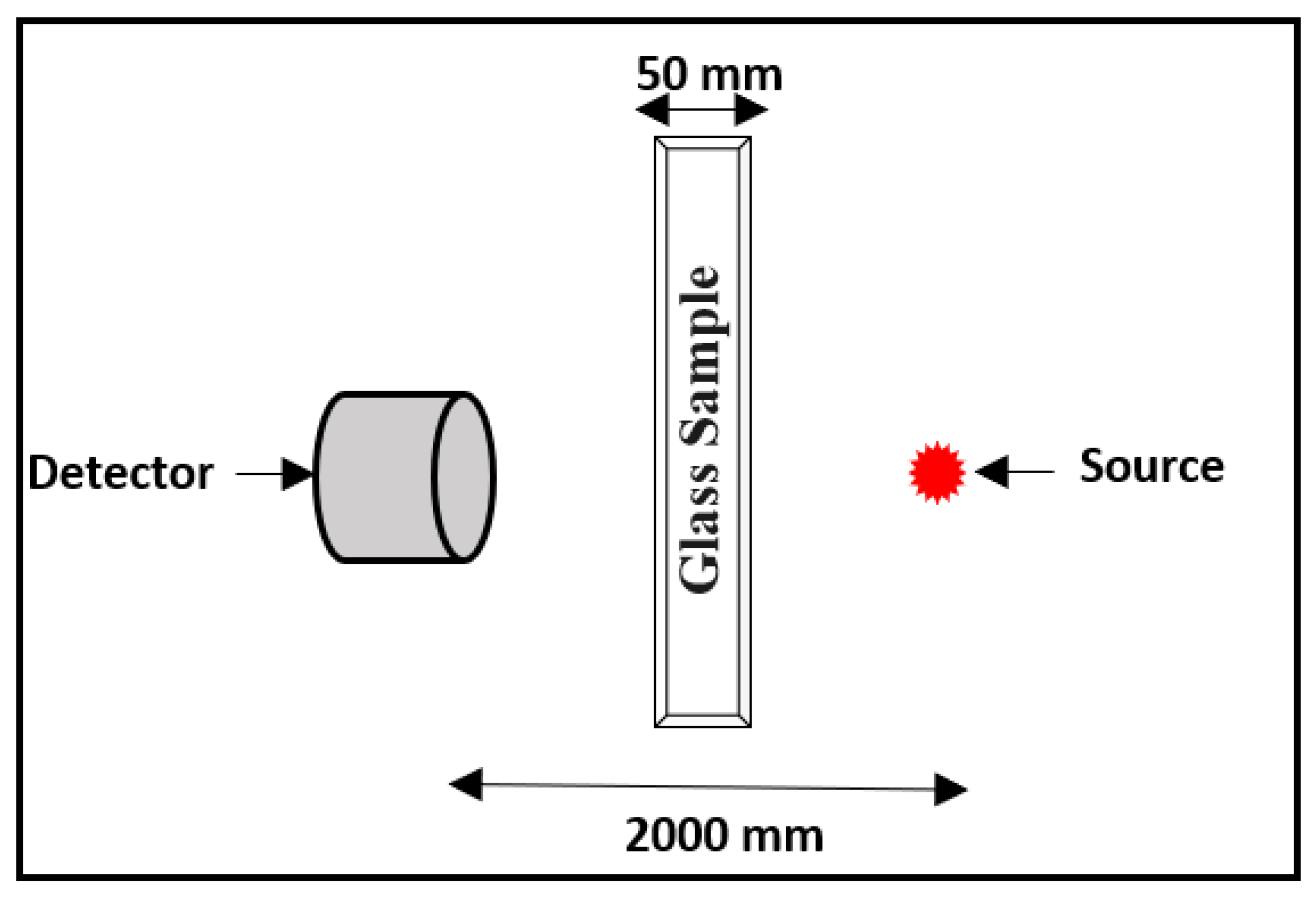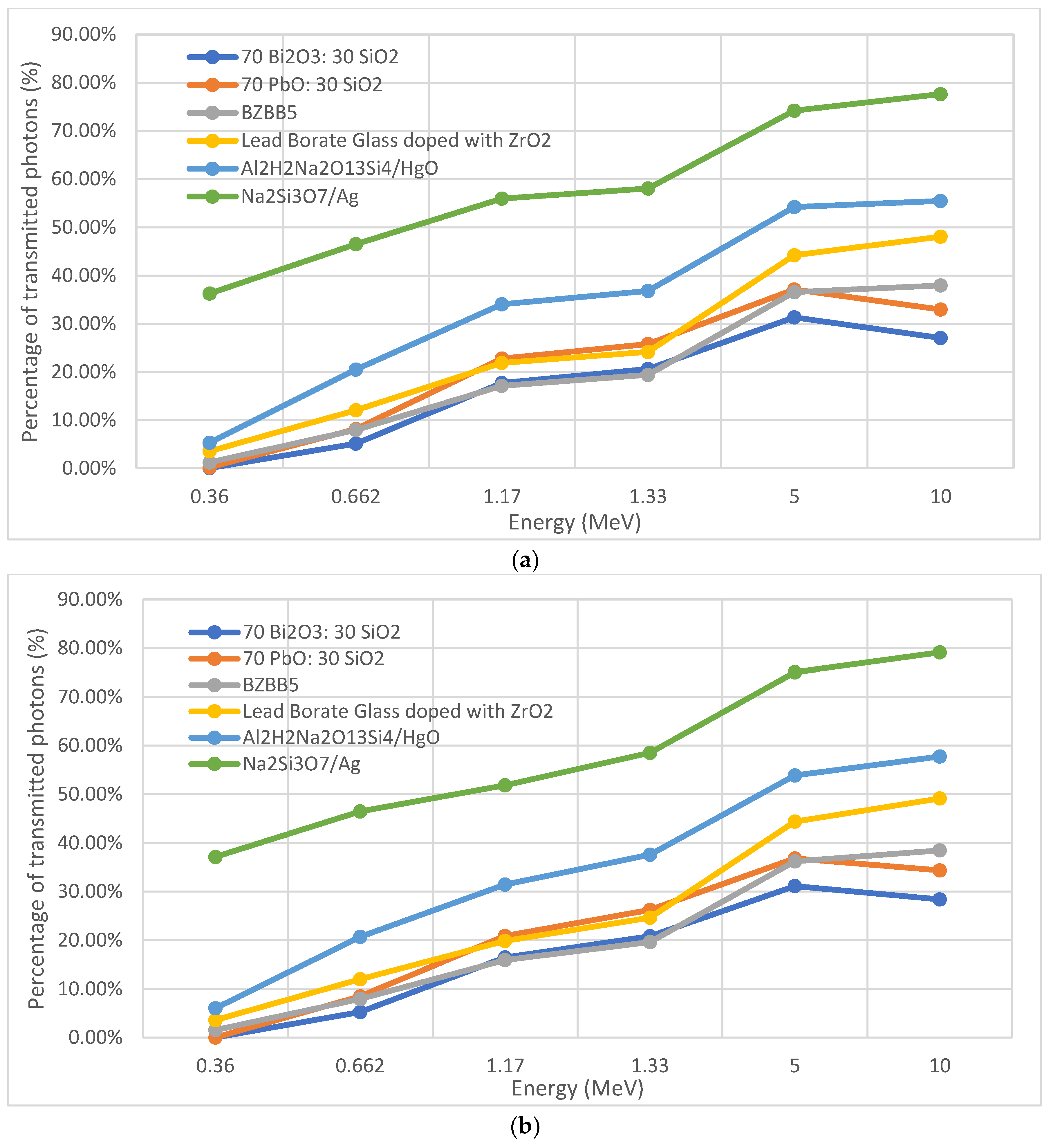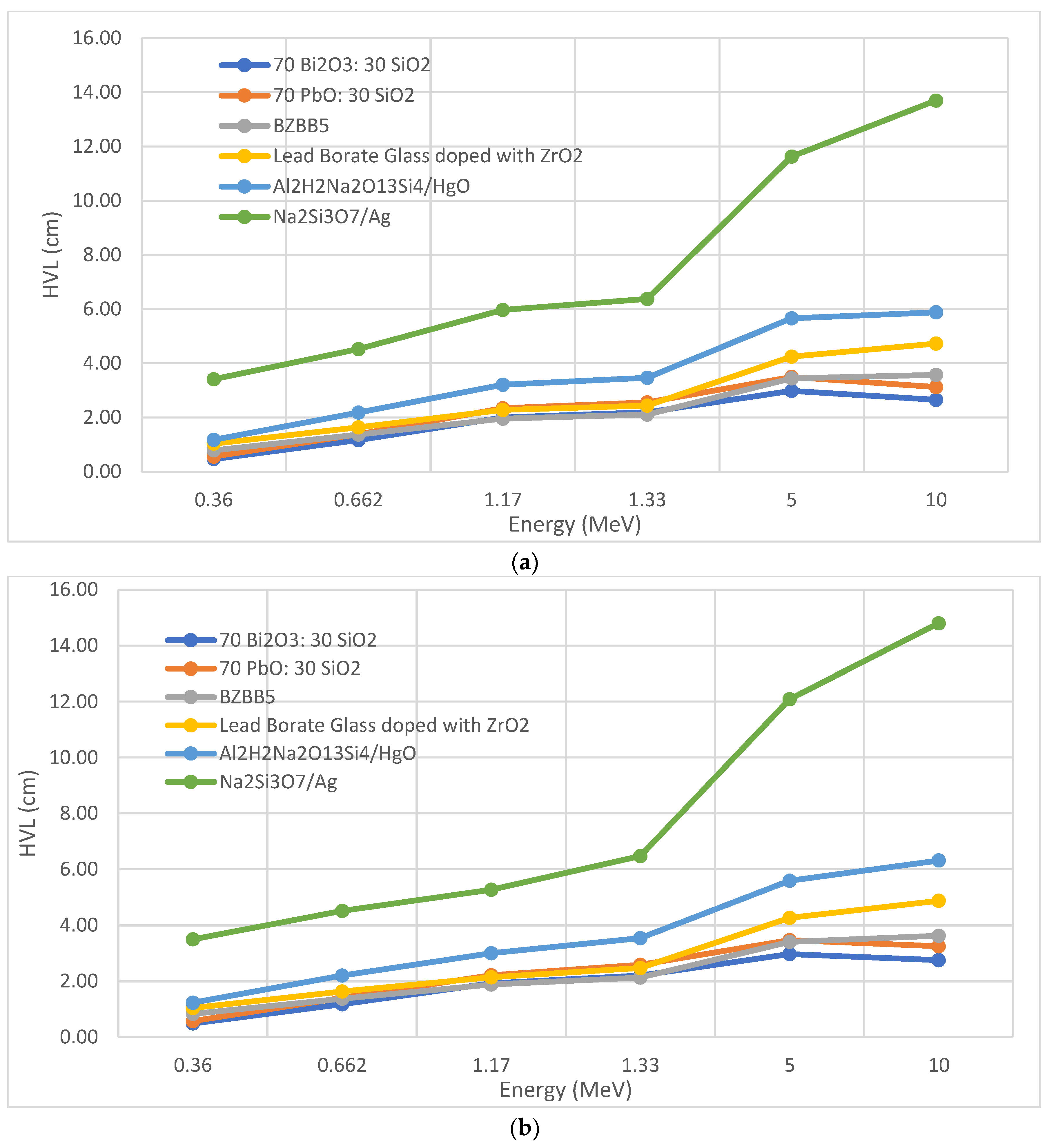Operator Protection from Gamma Rays Using Ordinary Glass and Glass Doped with Nanoparticles
Abstract
1. Introduction
2. Materials and Methods
3. Results and Discussions
4. Conclusions
Author Contributions
Funding
Institutional Review Board Statement
Informed Consent Statement
Data Availability Statement
Acknowledgments
Conflicts of Interest
References
- Daghbouj, N.; Sen, H.S.; Callisti, M.; Vronka, M.; Karlik, M.; Duchoň, J.; Čech, J.; Havránek, V.; Polcar, T. Revealing nanoscale strain mechanisms in ion-irradiated multilayers. Acta Mater. 2022, 229, 117807. [Google Scholar] [CrossRef]
- Daghbouj, N.; Sen, H.S.; Čížek, J.; Lorinčí, J.; Karlik, M.; Callisti, M.; Čech, J.; Havránek, V.; Li, B.; Krsjak, V.; et al. Characterizing heavy ions-irradiated Zr/Nb: Structure and mechanical properties. Mater. Des. J. 2022, 219, 110732. [Google Scholar] [CrossRef]
- Bray, D.E.; Stanley, R.K. Military Handbook: Nondestructive Evaluation: A Tool in Design, Manufacturing and Service; CRC Press: Boca Raton, FL, USA, 2018. [Google Scholar]
- Nasrazadani, S.; Hassani, S. Modern analytical techniques in failure analysis of aerospace, chemical, and oil and gas industries. In Handbook of Materials Failure Analysis with Case Studies from the Oil and Gas Industry; Elsevier: Amsterdam, The Netherlands, 2016. [Google Scholar]
- Sandle, T.; Saghee, M.R. Some considerations for the implementation of disposable technology and single- use systems in biopharmaceuticals. J. Commer. Biotechnol. 2011, 17, 319–329. [Google Scholar] [CrossRef]
- Zubair, M.; Ahmed, E.; Hartanto, D. Comparison of different glass materials to protect the operators from gamma-rays in the PET using MCNP code. Radiat. Phys. Chem. J. 2022, 190, 109818. [Google Scholar] [CrossRef]
- Manohara, S.R.; Hanagodimath, S.M.; Gerward, L. Photon interaction and energy absorption in glass: A transparent gamma-ray shield. J. Nucl. Mater. 2009, 393, 465–472. [Google Scholar] [CrossRef]
- Lakshminarayana, G.; Dong, M.G.; Al-Buriahi, M.S.; Kumar, A.; Lee, D.E.; Yoon, J.; Park, T. B2O3–Bi2O3–TeO2–BaO and TeO2–Bi2O3–BaO glass systems: A comparative assessment of gamma-ray and fast and thermal neutron attenuation aspects. Appl. Phys. A 2020, 126, 1–18. [Google Scholar] [CrossRef]
- Singh, K.J.; Kaur, S.; Kaundal, R.S. Comparative study of gamma-ray shielding and some properties of PbO-SiO2-Al2O3 and Bi2O3-SiO2-Al2O3 glass systems. Radiat. Phys. Chem. 2014, 96, 153–157. [Google Scholar] [CrossRef]
- Manonara, S.R.; Hanagodimath, S.M.; Gerward, L.; Mittal, K.C. Exposure buildup factors for heavy metal oxide glass: A radiation shield. J. Korean Phys. Soc. 2011, 59, 2039–2042. [Google Scholar] [CrossRef]
- Bagshaw, M.; Barbeau, D.N. Chapter 44—The Aircraft Cabin Environment. In Travel Medicine, 3rd ed.; Elsevier: Amsterdam, The Netherlands, 2013; Available online: https://www.sciencedirect.com/science/article/pii/B9781455710768000442 (accessed on 27 December 2022).
- Khanal, L.R.; Sundararajan, J.A.; Qiang, Y. Advanced nanomaterials for nuclear energy and nanotechnology. Energy Technol. 2020, 8, 1901070. [Google Scholar] [CrossRef]
- Malekzadeh, R.; Sadeghi Zali, V.; Jahanbakhsh, O.; Okutan, M.; Mesbahi, A. The preparation and characterization of silicon-based composites doped with BaSO4, WO3, and PbO nanoparticles for shielding applications in PET and nuclear medicine facilities. Nanomed. J. 2020, 7, 324–334. [Google Scholar]
- Singh, V.P.; Badiger, N.M.; Kaewkhao, J. Radiation shielding competence of silicate and borate heavy metal oxide glasses: Comparative study. J. Non-Cryst. Solids 2014, 404, 167–173. [Google Scholar] [CrossRef]
- Mostafa, A.M.A.; Zakaly, H.M.; Pyshkina, M.; Issa, S.A.; Tekin, H.O.; Sidek, H.A.A.; Zaid, M.H.M. Multi-objective optimization strategies for radiation shielding performance of BZBB glasses using Bi2O3: A FLUKA Monte Carlo code calculation. J. Mater. Res. Technol. 2020, 9, 12335–12345. [Google Scholar] [CrossRef]
- Çağlar, M.; Karabul, Y.; Kılıç, M.; Özdemir, Z.G.; İçelli, O. Na2Si3O7/Ag micro and nano-structured glassy composites: The experimental and MCNP simulation surveys of their radiation shielding performances. Prog. Nucl. Energy 2021, 139, 103855. [Google Scholar] [CrossRef]
- Allam, A.E.; El-Sharkawy, R.M.; El-Taher, A.; Shaaban, E.R.; Elsaman, R.; El Sayed Massoud, E.; Mahmoud, M.E. Enhancement and optimization of gamma radiation shielding by doped nano HgO into nanoscale bentonite. Nucl. Eng. Technol. 2022, 54, 2253–2261. [Google Scholar] [CrossRef]
- Abdel Wahab, E.A.; Shaaban, K.S.; Elsaman, R.; Yousef, E.S. Radiation shielding and physical properties of lead borate glass-doped ZrO2 nanoparticles. Appl. Phys. A 2019, 125, 1–15. [Google Scholar] [CrossRef]
- De Angelis, A.; Tatischeff, V.; Argan, A.; Brandt, S.; Bulgarelli, A.; Bykov, A.; Zoglauer, A. Gamma-ray astrophysics in the MeV range. Exp. Astron. 2021, 51, 1225–1254. [Google Scholar] [CrossRef]
- Schimmerling, W.; Wilson, J.W.; Nealy, J.E.; Thibeault, S.A.; Cucinotta, F.A.; Shinn, J.L.; Kiefer, R. Shielding against galactic cosmic rays. Adv. Space Res. 1996, 17, 31–36. [Google Scholar] [CrossRef] [PubMed]
- Goorley, T.; James, M.; Booth, T.; Brown, F.; Bull, J.; Cox, L.J.; Durkee, J.; Elson, J.; Fensin, M.; Forster, R.A.; et al. Is lead dust within nuclear medicine departments a hazard to pediatric patients? J. Nucl. Med. Technol. 2013, 37, 170–172. [Google Scholar]
- Knoll, G. Radiation Detection and Measurement, 3rd ed.; John Wiley & Sons, Inc.: Hoboken, NJ, USA, 2000. [Google Scholar]
- Berger, M.J.; Hubbell, J.H. XCOM: Photon Cross-Sections Database, Web Version 1.2 n.d. 2022. Available online: https://www.nist.gov/pml/productsservices/physical-reference-data (accessed on 27 December 2022).
- Choppin, G.R.; Liljenzin, J.; Rydberg, J. Chapter 6–Absorption of Nuclear Radiation. In Radiochemistry and Nuclear Chemistry Book, 3rd ed.; 2002; pp. 123–165. Available online: https://www.sciencedirect.com/science/article/pii/B9780750674638500066 (accessed on 27 December 2022).
- Gundogdua, O.; Tarimb, U.A.; Gurlerb, O. Monte Carlo calculations for photon attenuation studies on different solid phantom materials. In Proceedings of the 3rd International Conference on Computational and Experimental Science and Engineering, Banda Aceh, Indonesia, 11–12 October 2021. [Google Scholar]
- Sayyed, M.I.; Mohammed, F.Q.; Mahmoud, K.A.; Lacomme, E.; Kaky, K.M.; Khandaker, M.U.; Faruque, M.R. Evaluation of radiation shielding features of Co and Ni-based superalloys using MCNP-5 code: Potential use in nuclear safety. Appl. Sci. J. 2020, 10, 7680. [Google Scholar] [CrossRef]





| Glass | Density (g/(cm)3) | Elemental Fraction |
|---|---|---|
| Conventional Glass | ||
| BZBB5 | 6.15 | Zn: 0.321369; O: 0.31643; Bi: 0.224247; B: 0.093171; Ba: 0.044783 |
| 70 Bi2O3:30 SiO2 | 5.69 | O: 0.125519; Si: 0.024494; Bi: 0.849987 |
| 70 PbO:30 SiO2 | 4.93 | O: 0.119337; Si: 0.048333; Pb: 0.832330 |
| Glass Doped With Nanoparticles | ||
| Na2Si3O7/Ag | 2.012 | Na: 0.2711; O: 0.0656; Si: 0.5533; Ag: 0.11 |
| Al2H2Na2O13Si4/HgO | 3.647 | Hg: 0.3705; Al: 0.0767; H: 0.0029; Na: 0.0635; O: 0.3251; Si: 0.1596 |
| Lead Borate Glass Doped with ZrO2 | 5.29 | Zr: 0.17768; O: 0.40077; Na: 0.12796; B: 0.12035; Pb: 0.17325 |
| Glass Sample | 0.36 MeV | 0.66 MeV | 1.17 MeV | 1.33 MeV | 5 MeV | 10 MeV | ||||||
|---|---|---|---|---|---|---|---|---|---|---|---|---|
| Theo. | Sim. | Theo. | Sim. | Theo. | Sim. | Theo. | Sim. | Theo. | Sim. | Theo. | Sim. | |
| 70 Bi2O3:30 SiO2 | 1.47 | 1.43 | 0.59 | 0.59 | 0.35 | 0.36 | 0.32 | 0.31 | 0.23 | 0.23 | 0.26 | 0.25 |
| 70 PbO:30 SiO2 | 1.22 | 1.21 | 0.50 | 0.49 | 0.30 | 0.31 | 0.27 | 0.27 | 0.19 | 0.20 | 0.22 | 0.21 |
| BZBB5 | 0.88 | 0.84 | 0.51 | 0.51 | 0.35 | 0.37 | 0.33 | 0.32 | 0.20 | 0.20 | 0.19 | 0.19 |
| Lead borate glass doped with ZrO2 | 0.67 | 0.66 | 0.42 | 0.42 | 0.30 | 0.32 | 0.28 | 0.28 | 0.16 | 0.16 | 0.15 | 0.14 |
| Al2H2Na2O13Si4/HgO | 0.59 | 0.56 | 0.32 | 0.31 | 0.22 | 0.23 | 0.20 | 0.19 | 0.12 | 0.12 | 0.12 | 0.11 |
| Na2Si3O7/Ag | 0.20 | 0.19 | 0.15 | 0.15 | 0.12 | 0.13 | 0.11 | 0.10 | 0.06 | 0.05 | 0.05 | 0.05 |
| Glass Sample | 0.36 MeV | 0.66 MeV | 1.17 MeV | 1.33 MeV | 5 MeV | 10 MeV | ||||||
|---|---|---|---|---|---|---|---|---|---|---|---|---|
| Theo. | Sim. | Theo. | Sim. | Theo. | Sim. | Theo. | Sim. | Theo. | Sim. | Theo. | Sim. | |
| 70 Bi2O3:30 SiO2 | 0.06 | 0.08 | 5.16 | 5.25 | 17.73 | 16.5 | 20.60 | 20.8 | 31.32 | 31.1 | 27.09 | 28.4 |
| 70 PbO:30 SiO2 | 0.22 | 0.22 | 8.17 | 8.47 | 22.76 | 20.9 | 25.79 | 26.3 | 37.12 | 36.8 | 32.98 | 34.3 |
| BZBB5 | 1.25 | 1.54 | 7.97 | 7.94 | 17.15 | 15.9 | 19.40 | 19.7 | 36.57 | 36.2 | 37.95 | 38.5 |
| Lead borate glass doped with ZrO2 | 3.55 | 3.59 | 12.06 | 12.0 | 21.87 | 19.8 | 24.19 | 24.6 | 44.24 | 44.4 | 48.06 | 49.1 |
| Al2H2Na2O13Si4/HgO | 5.33 | 6.00 | 20.47 | 20.7 | 34.05 | 31.5 | 36.81 | 37.6 | 54.21 | 53.9 | 55.49 | 57.8 |
| Na2Si3O7/Ag | 36.26 | 37.1 | 46.49 | 46.5 | 55.99 | 51.9 | 58.10 | 58.5 | 74.23 | 75.1 | 77.65 | 79.1 |
| Glass Sample | 0.36 MeV | 0.66 MeV | 1.17 MeV | 1.33 MeV | 5 MeV | 10 MeV | ||||||
|---|---|---|---|---|---|---|---|---|---|---|---|---|
| Theo. | Sim. | Theo. | Sim. | Theo. | Sim. | Theo. | Sim. | Theo. | Sim. | Theo. | Sim. | |
| 70 Bi2O3:30 SiO2 | 0.47 | 0.49 | 1.17 | 1.18 | 2.00 | 1.92 | 2.19 | 2.21 | 2.99 | 2.97 | 2.65 | 2.75 |
| 70 PbO:30 SiO2 | 0.57 | 0.57 | 1.38 | 1.40 | 2.34 | 2.21 | 2.56 | 2.59 | 3.50 | 3.47 | 3.12 | 3.25 |
| BZBB5 | 0.79 | 0.83 | 1.37 | 1.37 | 1.97 | 1.88 | 2.11 | 2.13 | 3.45 | 3.41 | 3.58 | 3.63 |
| Lead borate glass doped with ZrO2 | 1.04 | 1.04 | 1.64 | 1.63 | 2.28 | 2.14 | 2.44 | 2.47 | 4.25 | 4.27 | 4.73 | 4.88 |
| Al2H2Na2O13Si4/HgO | 1.18 | 1.23 | 2.19 | 2.20 | 3.22 | 3.00 | 3.47 | 3.54 | 5.66 | 5.60 | 5.88 | 6.32 |
| Na2Si3O7/Ag | 3.42 | 3.50 | 4.52 | 4.52 | 5.98 | 5.28 | 6.38 | 6.47 | 11.63 | 12.1 | 13.70 | 14.8 |
| Glass Sample | 0.36 MeV | 0.66 MeV | 1.17 MeV | 1.33 MeV | 5 MeV | 10 MeV | ||||||
|---|---|---|---|---|---|---|---|---|---|---|---|---|
| Theo. | Sim. | Theo. | Sim. | Theo. | Sim. | Theo. | Sim. | Theo. | Sim. | Theo. | Sim. | |
| 70 Bi2O3:30 SiO2 | 0.68 | 0.70 | 1.69 | 1.70 | 2.89 | 2.77 | 3.16 | 3.18 | 4.31 | 4.28 | 3.83 | 3.97 |
| 70 PbO:30 SiO2 | 0.82 | 0.83 | 2.00 | 2.03 | 3.38 | 3.19 | 3.69 | 3.74 | 5.05 | 5.00 | 4.51 | 4.68 |
| BZBB5 | 1.14 | 1.20 | 1.98 | 1.97 | 2.84 | 2.72 | 3.05 | 3.07 | 4.97 | 4.92 | 5.16 | 5.23 |
| Lead borate glass doped with ZrO2 | 1.50 | 1.50 | 2.36 | 2.36 | 3.29 | 3.09 | 3.52 | 3.57 | 6.13 | 6.16 | 6.82 | 7.04 |
| Al2H2Na2O13Si4/HgO | 1.71 | 1.78 | 3.15 | 3.17 | 4.64 | 4.32 | 5.00 | 5.11 | 8.17 | 8.08 | 8.49 | 9.11 |
| Na2Si3O7/Ag | 4.93 | 5.05 | 6.53 | 6.52 | 8.62 | 7.61 | 9.21 | 9.34 | 16.78 | 17.4 | 19.76 | 21.4 |
Disclaimer/Publisher’s Note: The statements, opinions and data contained in all publications are solely those of the individual author(s) and contributor(s) and not of MDPI and/or the editor(s). MDPI and/or the editor(s) disclaim responsibility for any injury to people or property resulting from any ideas, methods, instructions or products referred to in the content. |
© 2023 by the authors. Licensee MDPI, Basel, Switzerland. This article is an open access article distributed under the terms and conditions of the Creative Commons Attribution (CC BY) license (https://creativecommons.org/licenses/by/4.0/).
Share and Cite
Zubair, M.; Aamir, M.; Ahmed, E.; Alyemni, A.A. Operator Protection from Gamma Rays Using Ordinary Glass and Glass Doped with Nanoparticles. Sustainability 2023, 15, 1375. https://doi.org/10.3390/su15021375
Zubair M, Aamir M, Ahmed E, Alyemni AA. Operator Protection from Gamma Rays Using Ordinary Glass and Glass Doped with Nanoparticles. Sustainability. 2023; 15(2):1375. https://doi.org/10.3390/su15021375
Chicago/Turabian StyleZubair, Muhammad, Muhammad Aamir, Eslam Ahmed, and Abdullrahman Abdullah Alyemni. 2023. "Operator Protection from Gamma Rays Using Ordinary Glass and Glass Doped with Nanoparticles" Sustainability 15, no. 2: 1375. https://doi.org/10.3390/su15021375
APA StyleZubair, M., Aamir, M., Ahmed, E., & Alyemni, A. A. (2023). Operator Protection from Gamma Rays Using Ordinary Glass and Glass Doped with Nanoparticles. Sustainability, 15(2), 1375. https://doi.org/10.3390/su15021375











